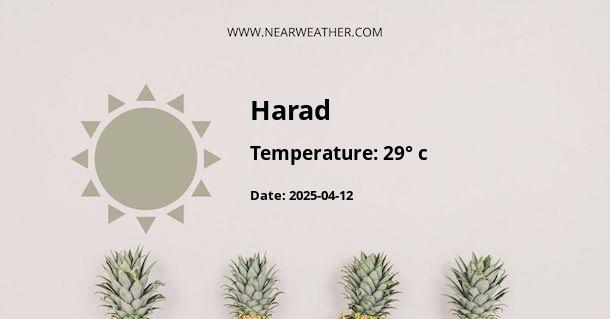Introduction: Harad, Yemen
Located in the western region of Yemen, Harad is a city that plays a significant role in the country's history and culture. Its geographical position, near the border with Saudi Arabia, makes it a significant hub for trade and commerce. However, the city is also known for its distinctive climate, which is predominantly hot desert (BWh) according to the Köppen-Geiger climate classification system. This article will delve into the various aspects of Harad's climate, providing detailed information on its weather patterns throughout the year.
Climate Overview
Harad's climate is characterized by extreme heat during most of the year, with very little rainfall. The city's position in the Tihama coastal plain, which stretches from the Red Sea coast of Yemen to Saudi Arabia, contributes to its arid climate. The average annual temperature is around 29.6°C, and the city gets approximately 88 mm of precipitation annually. The heat and lack of rainfall make Harad one of the hottest and driest places in Yemen.
Harad's climate is classified as hot desert climate (BWh) by the Köppen-Geiger system, with an average annual temperature of about 29.6°C and an annual rainfall of just 88 mm.
Monthly Weather Breakdown
To understand Harad's climate more comprehensively, it's worth examining the city's weather patterns on a monthly basis.
- January: The year begins with mild temperatures, typically averaging around 22.1°C. Rainfall is relatively low, with an average of 8 mm for the month.
- February: The temperature increases slightly to an average of 23.4°C. The rainfall remains consistent at around 8 mm.
- March: In March, temperatures continue to rise, averaging around 26.3°C. Rainfall drops slightly to about 5 mm.
- April: April sees a significant increase in temperature, with an average of 29.6°C. Rainfall is minimal, with an average of 3 mm.
- May: May is typically the hottest month in Harad, with temperatures averaging around 33.7°C. Rainfall is almost non-existent, averaging around 1 mm.
- June: The heat continues into June, with an average temperature of 33.2°C. Rainfall is slightly higher, at about 3 mm.
- July: July sees a slight decrease in temperature to an average of 32.5°C. Rainfall increases to around 10 mm.
- August: August is marginally cooler, with an average temperature of 31.9°C. Rainfall peaks for the year, averaging around 20 mm.
- September: In September, temperatures begin to decrease, with an average of 31.1°C. Rainfall drops to around 8 mm.
- October: October sees a further decrease in temperature to an average of 29.1°C. Rainfall remains steady at around 8 mm.
- November: November sees a significant drop in temperature to an average of 25.4°C. Rainfall drops slightly to about 6 mm.
- December: December is one of the cooler months in Harad, with an average temperature of 22.9°C. Rainfall is minimal, with an average of 3 mm.
Best Time to Visit Harad
Given Harad's predominantly hot and arid climate, the best time to visit the city is during the cooler months, specifically between November and February. During this period, the temperatures are more bearable, making outdoor activities and sightseeing more pleasant. However, even during these months, it's advisable for visitors to take precautions against the heat, such as wearing sun-protective clothing and staying hydrated.
Conclusion
Harad's climate is definitely for those who can withstand high temperatures and dry weather. Its hot desert climate, characterized by high temperatures and minimal rainfall, dominates most of the year. However, the cooler months between November and February offer a more comfortable climate for visitors. Understanding these weather patterns is essential for planning a trip to Harad or for those considering living in this unique city.
A - Harad's Latitude is 16.409651 & Longitude is 43.058830.
A - Weather in Harad is 29° today.
A - Climate Conditions in Harad shows few clouds today.
A - Humidity in Harad is 56% today.
A - Wind speed in Harad is 1.4 km/h, flowing at 38° wind direction. today.
